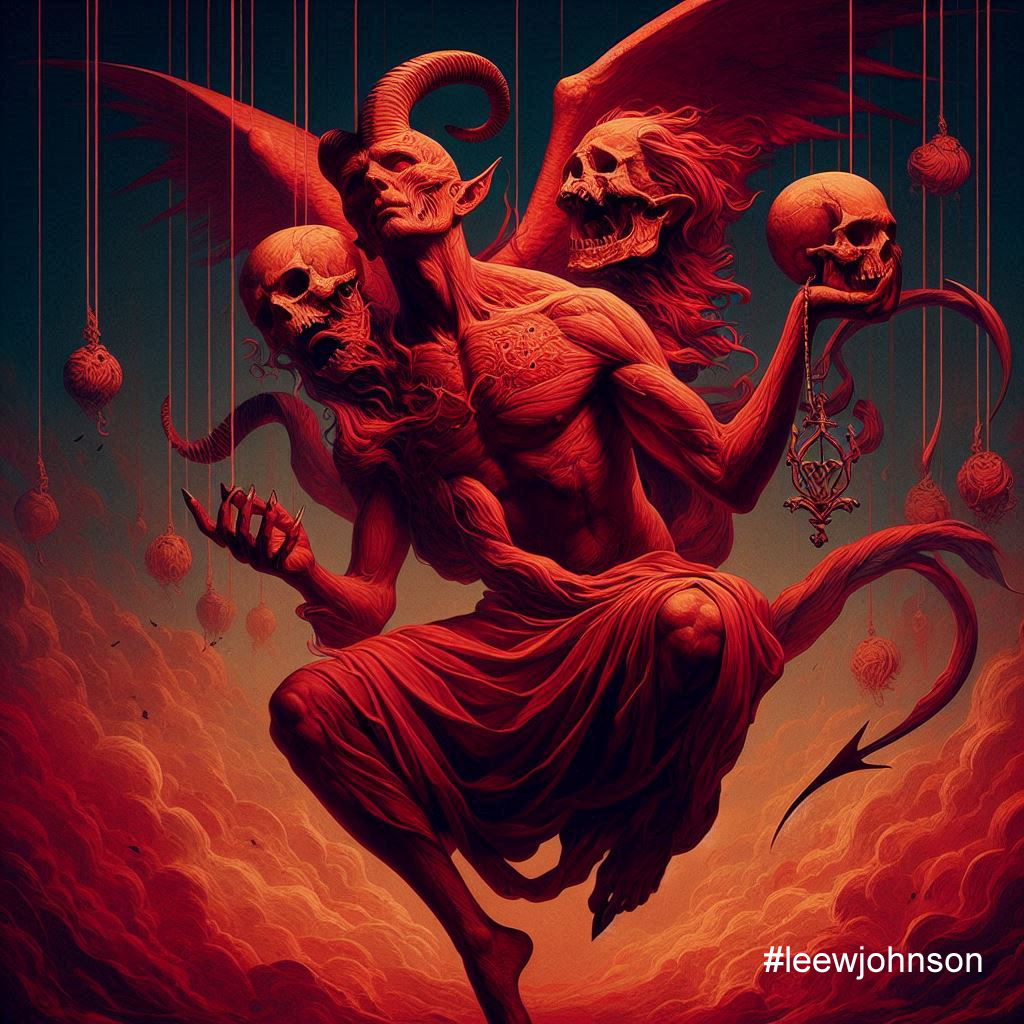Mephisto

Correspondences:
Colour: Black, Grey, Light Blue, Red
Direction: Northwest
Herb: Mandrake
Element: Earth
Planet: Mercury according to Jehannum, or Jupiter according to Faust as written in his book Praxis Magia Faustiana
Symbols: dog, the devil in general
Enn: Mephisto ramec viasa on ca
Most famously known from Johann Wolfgang von Goethe’s Faust, Mephisto often represents the dark side of human nature and the eternal struggle between good and evil. However, the character of Mephisto originates in European folklore and religious texts as a demon or devil figure, often associated with Satan or the Devil himself.
His name likely derives from a corrupted Greek compound. The Greek particle of negation (μή, mē) and the Greek word for “love” or “loving” (φίλος, philos) are the first and last terms of the compound, but the middle term is a bit of a mystery in this regard. There are usually three possibilities spoken of, I’d say the most likely is the inclusion of the Greek word for “light” (φῶς, phos) making the name to basically mean “not loving light”. This title could put him in the same arena as other Evening Star figures such as Hesperus, Noctifer an Lucifuge Rofocale and therefore a counterpart to Lucifer and the Morning Star. However, according to Jehannum, the name originates from the Hebrew word Mephir meaning “Destroyer”.
The character first gained prominence in literature through the German Faustbuch in the late 16th century, a collection of stories about the historical figure Johann Georg Faust, a scholar and occultist who allegedly made a pact with the Devil. This work laid the groundwork for later adaptations, particularly Goethe’s Faust, where Mephisto’s role was solidified as the tempter who bargains for Faust’s soul in exchange for knowledge and worldly pleasures.
Goethe’s Faust is the most influential portrayal of Mephisto, transforming him from a mere demon into a complex, multifaceted character. In Goethe’s work, Mephisto is not just a bringer of evil but also a cynical intellectual, representing reason and skepticism. He challenges divine authority and questions the moral order of the universe, serving as a catalyst for Faust’s existential journey.
Mephisto’s relationship with Faust is one of mutual dependence and antagonism. While he seeks to claim Faust’s soul, he also provides him with the means to pursue his deepest desires, embodying the paradoxical nature of temptation. Mephisto’s cynicism and wit make him a more engaging character than the traditional depictions of Satan, offering a philosophical dimension to the age-old battle between good and evil.
Mephisto’s cultural significance extends beyond Goethe’s Faust. He has become an archetype of the tempter in literature, theatre, and film. His influence can be seen in various adaptations of the Faust legend, as well as in other works that explore the theme of a pact with the devil, such as Doctor Faustus by Christopher Marlowe and The Master and Margarita by Mikhail Bulgakov.
In modern culture, Mephisto has been reinterpreted in various forms, from comic books and movies to music and video games. His character continues to resonate with people because he embodies the eternal human struggle with temptation, ambition, and the quest for knowledge. He represents the darker aspects of human nature and the lure of power.
Mephisto serves as a symbol of several profound ideas. In one aspect, he is the personification of doubt and skepticism, questioning the established moral and divine order. His role in Faust and other works suggests that this idea of evil is not always a force of pure destruction but can also be a catalyst for growth and change. Mephisto’s challenges force Faust to confront his own limitations and desires, leading to a deeper understanding of himself and the world.
Moreover, Mephisto embodies the duality of human nature. He is a tempter who exploits Faust’s weaknesses, but he also brings to light the potential for greatness and self-discovery. This duality is central to the human condition, where the line between good and evil is often blurred, and moral choices are rarely clear-cut.
From a more magical perspective, Jehannum has a lot to add in regard to this spirit. To summarise:
Mephistophiles, a chief demon and Keeper of the Book of Death, is deeply associated with witchcraft, dark magick, and a range of mystical practices such as necromancy and alchemy. He is also connected to emotions and traits like ambition, deception, and vengeance. Known for his quick results in magick, Mephistophiles can bestow wealth, teach various arts, and provide powerful familiars. He is often described as Lucifer’s companion, counterpart, or servant.
Personal gnosis suggests Mephistophiles can enhance social skills, intelligence, and physical fitness, and influence areas like flirtation, seduction, and sexuality. He is also believed to help with conditions like autism and dyslexia, depending on the practitioner’s skill.
Various texts portray Mephistophiles in different forms—such as a toad, black dog, bear, or bald man in a black cape—and ascribe to him roles of deception, shapeshifting, and infernal guidance. Some texts, like “The Sixth and Seventh Books of Moses,” describe him as eager to assist with any skill or art, while others, like “The Black Raven,” highlight his influence over luck and rapid learning.
The name Mephistophiles has been interpreted in several ways, ranging from “He Who Loves Not the Light” to “Dispenser of Lies” and even “Friend of Stench.” Despite various attempts to link him to other entities like Lucifuge Rofocale, the identification remains speculative and should be approached with caution. Mephistophiles is better understood as a unique entity with complex attributes rather than through uncertain etymological connections.
Mirta Wake summarises his office as: keeper of the book of death, presumably all those that made the deal with the devil, potentially all of those that died (sourced from S. Connolly), grand master of luck, skilled arts and speed of learning (The Black Raven).